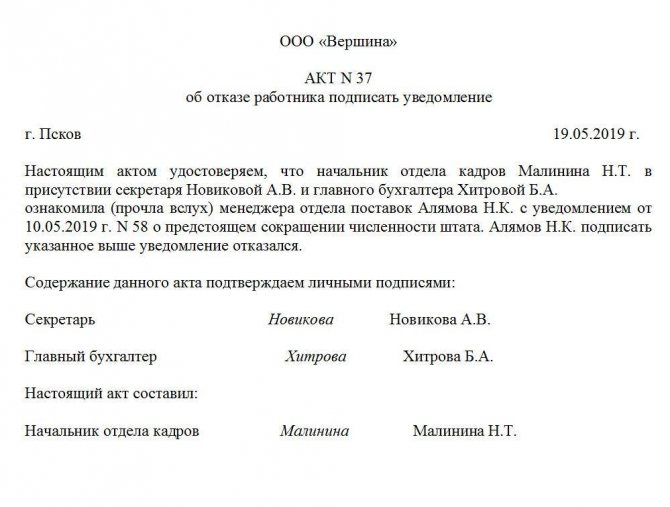If you refuse to sign an official or other document, do not be nervous - draw up an act of refusal to sign. Like an act of refusal to receive, such a document records the fact that a person has been made aware of any information, but refuses to sign and confirm it.
The act of refusal to sign is accepted by the court as evidence in a civil case only if it is drawn up correctly. And how to do this can be seen in the example below, which can be adapted to absolutely any situation. Moreover, the official form of such a document is not fixed. In case of difficulties, you can contact the site’s on-duty lawyer for free advice.
:
Certificate of refusal to sign
Why do you need a signature on the deed?
Any deed is always signed by at least two parties.
Sometimes, to draw up and sign a particular act, entire commissions are involved, which include employees of different structural divisions or representatives of various companies - all of them are required to sign the document.
Their autographs indicate that the information included in the act is correct, the parties are familiar with it and agree with it.
But if one of the parties directly related to the act refuses to sign it for some reason, the document can be marked accordingly or a separate act can be drawn up in connection with this. This document will be proof of the fact that the original act was presented to the second party and all the conditions from this point of view were fulfilled by the drafter of the act.
It should be noted that a strictly defined time is usually allotted for signing an act (for different types of acts it can be different and is established either by the legislation of the Russian Federation or by an agreement between the parties), so before drawing up an act of refusal to sign the act, this period should be met.
We draw up an act
The form of the act is not regulated by law. It can be approved by order of the enterprise or be arbitrary. As a rule, the forms are included in the relevant internal regulatory documents of the enterprise.
A note indicating the party’s refusal to sign the act may also be placed on the document itself.
Drawing up an act of refusal to sign the act requires the participation of the persons who drew up the original document. In some cases, signatures will also confirm the fact that the original document was provided to the party.
The structure of the act assumes the following sections:
- at the top of the document the number, date, place of preparation of the document, name of the enterprise and title of the document are indicated (the so-called “header”);
- the motivational part, that is, a listing of the circumstances that formed the basis of the act, indicating the positions of the persons making up the act and the full name of the person who refused to sign the act. It is mandatory that the act of refusal must contain an indication of the original document (“refused to familiarize yourself with the act of acceptance and transfer of inventory items dated... year No.... under the supply agreement dated... year No....");
- if the person who refused to sign the act somehow justifies his refusal, this must also be included in the document (“due to disagreement with the reason for removal from work”);
- signatures of the persons drawing up the act. It is recommended, if possible, to invite the party who refused to sign the act itself to sign an act of refusal. In some cases, an employee or counterparty who refused to sign the original act puts their signatures on the act of refusal.
The act is drawn up in two copies. One remains with the organization, the other is transferred to the person who refused to sign the act. Acts of refusal to draw up an act are accepted by the courts as evidence in a dispute.
Acts of refusal to sign the act are usually stored with the original acts or in a package of documents for the order, for example, if the act is included in the materials of the internal audit, based on the findings of which a dismissal order was issued against the employee, etc. at the place of its compilation, at least three years. The organization itself can increase the storage period of certain groups of acts (for example, acts - annexes to orders on discipline).
What happens if you refuse to sign?
Refusal to sign any document, including an act, is an inalienable right of any party to a contractual relationship.
At the same time, what kind of agreement was concluded between the parties does not matter: it could be an employment contract, a purchase and sale agreement, a work contract, etc.
Some enterprise employees and representatives of partner organizations, refusing to sign the act, believe that in this way they are depriving it of its validity. This is wrong. According to all the rules, the executed document will in any case be legal, provided that all the data entered into it corresponds to reality.
Thus, by and large, refusal to sign is only indirect evidence that the other party does not recognize and does not agree with the facts and circumstances stated in the act.
In the absence of measures to find a compromise and defend their interests, the disagreeing party may go to court.
Is a signature required on the deed?
As a rule, the deed is drawn up by one interested party and provided to the other party or parties for review and signature. In some cases, the other party or parties, after reviewing it, may not agree with the contents of the act and refuse to sign. Quite often, such a refusal may follow from the misconception that if one of the parties does not sign the document, then the document will be invalid. However, it is not.
The refusal of a party to sign the act is its right, but does not deprive the document of legal force, provided that the very fact of providing the act for review and signature is recorded.
Thus, the act of refusal to sign the act performs two functions:
- allows you to confirm that the document was actually provided to the interested party for review;
- allows you to record the very fact of refusal to sign.
The following grounds have been established for drawing up an act of refusal to sign the act:
- express refusal of the party to sign the document after familiarization;
- expiration of the period specified in the law or in the contract as the time allotted to the party to sign the act.
As a rule, contracts for the performance of work or the provision of services initially indicate the time period allotted to the party for signing the act presented to it, for example, 15 days after receipt, 30 days, etc. The act of refusal to sign the act, therefore, can be drawn up only after the expiration of the period specified in the contract. If the document is drawn up earlier, it will not be valid.
Sample of drawing up an act of refusal to sign the act
Today there is no standard unified sample act, so the document can be written in any form or according to a template that operates within the company. At the same time, there is a number of certain information that must be included in it:
- date of compilation,
- Document Number,
- the locality in which the company is registered and its name.
In the main part you should indicate:
- who exactly refuses to sign the act (if these are representatives of another organization - its name, position and full name of employees, if an employee of the enterprise itself - only position and full name),
- a link to the act that the other party refuses to sign (its number and date of writing), as well as briefly convey the essence of the above-mentioned document,
- if the opponent gives some explanation for his refusal, they also need to be included here (the more detailed this part is described, the better).
It is necessary to include in the act information about all people related to its preparation (members of the commission or witnesses), indicating their positions, surnames, first names and patronymics.
If there are any additional documents, they must be added to the act, marked as a separate paragraph.
A well-executed document is a guarantee of protection
Only if the act is drafted and executed in a high-quality manner can it serve as a guarantee of protection for the employer or executive body responsible for reviewing the document in the event of a dispute or litigation.
The quality of a document consists of:
- availability of all details provided for by the state standard;
- availability of comprehensive information about activated facts or events.
The composition and arrangement of document details is regulated by GOST R 6.30-2003 (from July 1, 2021, GOST R 7.0.97-2016 Requirements for document preparation comes into force). For an act of refusal to affix a signature, this is:
- name of company;
- name of the document type;
- date of;
- registration number;
- place of compilation;
- title to the text;
- text;
- signature. How to sign a document with an electronic signature - read here.
A sample of filling out an act on the employee’s refusal to sign an order.
The header part can be designed longitudinally or angularly. In the first case, the entire width of the working area of the sheet is used for design, in the second - only the left half.
Document structure requirements
There are no standard requirements for the text of the act of refusal to sign. The general requirements for the structure of its text are as follows:
1) introductory part (here the details of the instructional or administrative document on the basis of which the activation is carried out are indicated, the persons participating in the activation are listed, indicating positions, surnames and initials);
2) the main part (the facts are formulated here, the number of copies of the act is indicated and to whom each of them will be transferred).
Step-by-step drawing up of the act
Step 1 – check before drawing up the act:
- what local regulatory act is regulated (date, number, title);
- who will be on the commission (last name, initials, exact job title);
- details of the document that needs to be familiarized with signature (date, number, title);
- surname, initials and position of the employee who needs to read the document and sign it. Here you will learn how to obtain an electronic signature for an individual.
Form of the act of refusal to sign.
Step 2 – draw up the title part of the act:
- full name of the enterprise (as specified in the Charter);
- title of the document in capital letters;
- date and number of the act;
- place of compilation (name of the locality, if it does not follow from the name of the enterprise);
- title.
What is a power of attorney for the right to sign documents and how to draw it up correctly, you will learn in the article at the link.

Sample act of refusal to sign a notice.
Step 3 – complete the introductory part (make sure that the names of the commission members are in alphabetical order and that all data is presented without errors).
Step 4 – design the main part:
- state in as much detail as possible the fact of familiarization with the document (by whom, when, at what time, where exactly, who, in the presence of whom, how they familiarized themselves with the document, indicate the date, number, type of document, title of the document);
- reflect the fact of refusal to sign (who and why refused to sign);
- indicate how many copies of the act have been issued and to whom each of them is intended;
- complete the signatures of the chairman and members of the commission (make sure that all members of the commission sign).
Refusal to serve a notice is formalized in the same way. The title of the act and the content of the main part will differ, since the event of delivery of the notice can occur in different ways.
What to pay attention to when drawing up a deed
When drawing up an act, as well as when writing it, you can rely on your own vision of the document, since the law does not impose any special requirements on this parameter. The act can be written on a simple blank sheet of paper or on the organization’s letterhead. You can enter information by hand (with a ballpoint pen of any dark color, but not a pencil) or type it on a computer.
It is important to comply with the condition : the act must contain the signatures of its immediate compiler and the employees present - their autographs will indicate that all the information entered in the document is correct.
It is not necessary to certify the form of the act with a seal - from 2021, the use of stamped products in enterprises and organizations is necessary only in cases where this is enshrined in the internal regulatory documents of the company.
The act is drawn up in two copies :
- one of whom remains in the company,
- the second is transferred to the opponent.
If necessary, you can make additional copies of the act.
Types of acts
Acts are divided into types depending on their content and the circumstances of their preparation. The following documents can be highlighted:
- About write-off of assets.
- On the acceptance and transfer of assets/work/documents.
- About inspections of equipment/work results.
- About inspections.
- About violations in the field of labor discipline.
- Refusal to sign confirming familiarization with the order.
- Refusal to provide explanations regarding a disciplinary violation.
- About testing of equipment/samples.
- On the liquidation of the institution.
- About audit/inventory.
- On conducting an investigation into emergencies and accidents.
Acts usually state one fact or another. Let's look at an example. The manager issued an order, which, by law, must be familiarized to the employee. However, the latter refuses to sign. The fact of refusal must be recorded. This is what the act is used for.
Acts are required to confirm official misconduct. For example, these are the following types of violations:
- Failure to fulfill one's duties.
- Failure to follow the instructions of the manager.
- Absenteeism.
- Showing up at work while drunk.
Labor offenses are usually accompanied by the drawing up of these acts:
- About the walk.
- Refusal to provide explanations.
We suggest you read: Flooding of an apartment by neighbors from above: Judicial practice on flooding
It is especially important to draw up such acts correctly. This need is due to the fact that such documents are often disputed. The effect of the acts directly concerns the interests of the employee. The latter may well appeal to the labor inspectorate or court.
A document can be challenged on the sole ground that the document is drawn up incorrectly. For example, an employee showed up to work drunk. An act was drawn up on this fact. But this document was disputed due to the fact that it was drawn up without the presence of witnesses. Even if the employee was really drunk, it does not matter. A document has no legal force if it is drawn up incorrectly.
Compilation rules
When filling out, it is fundamentally important to take into account the timing. The more accurately the time is specified, the better. In court, questions will be asked regarding time periods and testimony will be compared. It is also advisable to mention in the text where the order was read (office, HR office, manager’s office, etc.).
It is acceptable to ask the question orally or read the document out loud to the employee. The main thing is that the refusal is clear. The text of the act may sound like this:
“I, the head of the HR department, Vasily Ivanovich Tarasov, in the presence of the cleaner Elena Vitalievna Markova and the manager Ivan Sergeevich Knyazev, have drawn up this act stating that...”
Employees or persons who agreed to record the fact of refusal must also be present in this room and clearly understand that the employee refused to read the order and sign on it. Witnesses must sign to confirm this fact. Only in this case will the act have legal force. If the employee refused to sign this document, then this can be written at the very end of the act. There is no need to draw up a separate document regarding refusal to sign.
Does an employee have the right to refuse to sign an order?
Article 21 of the Labor Code of the Russian Federation establishes the basic rights and obligations of employees. Among them, there is no obligation to sign all the employer’s orders with which the employee is introduced, much less agree with all his actions.
Moreover, a refusal to sign an order (close to it is a refusal to familiarize yourself with this document) can sometimes be regarded by law as self-defense by an employee of his rights (Article 379 of the Labor Code of the Russian Federation).
Some norms of the Labor Code of the Russian Federation stipulate what the employer should do if it is impossible to obtain the employee’s signature in reviewing the order.
Yes, Art. 84.1 of the Labor Code of the Russian Federation provides that an employee’s refusal to sign a dismissal order cannot stop this procedure. In this case, a corresponding entry is made on the order (“Refused to sign”).
Article 193 of the Labor Code of the Russian Federation, in the event of such an employee’s refusal, establishes the need to draw up a report.










